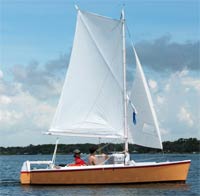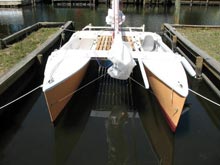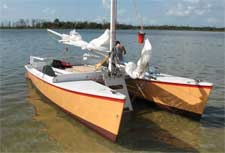After several years of scheming and 19 months of construction, my little beachcruising catamaran hit the water for the first time April 16. We launched her at a neighborhood ramp about a mile from the house, and all went remarkably well.
 |
After several years of scheming and 19 months of construction, my little beachcruising catamaran hit the water for the first time.
click images for larger views |
I live in Northwest Florida, an area with great potential for beachcruising. We have lots of wide-open bays and protected sounds, wilderness rivers and remote bayous, so it's a small boat paradise. Many boats could have filled the bill for a shallow-draft cruiser, but I wanted something pretty unusual.
I've always loved multihulls-- especially catamarans-- since the days when I owned a Wharram Tane. Cats are fast, light, stable, shallow draft and have lots of deck space. Unfortunately, from my extensive research, it appeared that no one had designed a small simple cruising catamaran of the kind I
wanted-- cabinless, modestly rigged, and with comfortable in-hull seating. I
couldn't understand this gap in the design spectrum, and I still can't, because there are plenty of tiny trimarans like this-- both manufactured boats and plans. But tris are poor load carriers compared to cats, and they are less suitable for pitching a tent on deck-- a necessity for comfortable beachcruising these days, since it's gotten hard to find a place ashore to pitch a tent.
Beachcruising in a tiny tri would be a lot like backpacking, because of the weight limitations. I wanted a higher degree of camping comfort, say, the kind of comfort you can have if horses carry your gear for you.
So, after much head-scratching and self-education, I drew a catamaran just under 16 feet in length, with a highway-legal fixed beam of 8 feet 6 inches.
| After much head-scratching and self-education, I drew a catamaran just under 16 feet in length, with a highway-legal fixed beam of 8 feet 6 inches. |
 |
The hulls are fine on the waterline, but flared to make it possible for two people to sit in comfortable contoured boat seats, one in each cockpit.
Because I wanted a simple-to-build, inexpensive boat, I designed a sprit-sloop rig-- an old-fashioned, low-tech approach, unusual for a potentially fast multihull. This was to be a boat for anxiety free cruising, so I drew a modest sail plan of 140 sq. ft. For comparison, a Hobie 16, which is about the same length, carries almost 80 sq. ft more sail, and is lighter. But if it capsizes, it can be righted by its crew, and my cat can't.
Because the nearest pass to the Gulf of Mexico is generally 5 miles to windward on summer afternoons, windward performance was very important to me, and I designed a big deep daggerboard with a NACA foil section, as well as high aspect kick-up rudders.
I had high hopes for the boat, but since this was my first design ever, I was prepared for disappointment.
 |
The hulls are fine on the waterline, but flared to make it possible for two people to sit in comfortable contoured boat seats, one in each cockpit. |
So far, however, the boat has greatly exceeded my hopes.
The sprit-sloop rig seems very powerful for its modest size. I built the mainsail at home, on the advice of Chuck Leinweber, Duckworks proprietor.
I'm no sailmaker, but it sets surprisingly well. I used the simple dart-at-the-tack-and-throat technique, rather than broadseaming, and built the sail out of a white polytarp. The jib is second-hand, from a Snipe, and is small, but adds a surprising amount of drive.
Winds were light for the first sail. The highest wind speed recorded around the area during the time we were out was 9.04 knots. Our best speed close reaching was 6.2 knots on the GPS, and we could make 5 to windward. Hull speed doesn't mean much for cats with low-resistance hulls, but ours is 5.1 knots.
Windward performance is surprisingly good. The Wednesday night yacht club race was going on while we were out, and we fell in for a while behind the slower end of the fleet on their windward leg. We were keeping up with 25 foot monos to windward-- not bad for a 16' cat built for comfort rather than speed.
| Hull speed doesn't mean much for cats with low-resistance hulls, but ours is 5.1 knots. |
 |
Overall, the feel of the boat is lively, but not at all squirrely, which I attribute to the long narrow hulls. The steering is very light and responsive once the rudders are in their down position. There's a modest amount of weather helm, which does not increase much in the puffs. Steering takes a little getting used to, because the steering lines have to be pulled in different directions, depending on which hull you steer from.
But it's so responsive that a small twitch of the line produces a noticeable shift in direction, so when I got confused, I'd twitch it one way, and if that was wrong, it was easy to twitch it back the other. Eventually I worked out a serviceable mnemonic to help me remember: to push the off bow away from me, I push the steering line forward; to pull the off bow toward me, I pull the steering line back.
The boat is very steady, and feels like a much bigger and more powerful boat.
There is little hobbyhorsing (though there wasn't a lot of chop, we did cross a couple powerboat wakes.) I was astonished at how dry the boat is. When we crossed those wakes, a little spray drifted back, but hardly a drop of water hit the decks while we were out. The seats are very comfortable, and we discovered that the best place to sit was near the forward end of the cockpit, where motion is least, and the balance is such that the transoms are clear of the water. Visibility is perfect, because your line of sight is well below the foot of both sails. The boat seems to be able to look after herself to an unusual degree. I found that if I took my hand from the steering line, the boat would slowly round up and sit with both sails luffing, for as long as we wanted.
 |
The boat is very steady, and feels like a much bigger and more powerful boat.
There is little hobbyhorsing. |
One of my big worries was how well the boat would tack, because cats are notorious for being slow (and sometimes impossible) to tack. That was one reason I went with the sprit-sloop rig, rather than a single sail-- if worse came to worst, I knew I could get the boat to tack by backing the jib. I was pleasantly surprised to discover it tacks better than any cat I've ever sailed on. No special technique is needed - you just put down the helm and across she goes, just like a monohull. At the end of our first sail, coming into a narrow bayou with the jib down and the wind very light, we were able to beat up the bayou with no difficulty.
My younger son and I went out fishing on Saturday. We sailed across the bay to Destin, with the intention of sailing into East Pass and trolling a bit.
Unfortunately, the onshore winds we'd had for several days had pushed a lot of water up into the bay, and it was all pouring out the pass into the Gulf.
The wind went light just about the time I realized there was a 4 knot current running out between the stone jetties. But the boat's light air performance was good enough to move us over to a patch of sand at the inland side of the east jetty. We were able to get an anchor down before we were swept into a line of breakers that extended all the way across the pass.
| I was pleasantly surprised to discover it tacks better than any cat I've ever sailed on. No special technique is needed - you just put down the helm and across she goes. |
 |
We spent a couple of hours there twirling around our anchor in a fierce eddy, but eventually the ebb slowed and a little wind came up, allowing us to sail out of the pass and under the bridge, back into the bay.
At this point, I thought we were home free, but the winds died back down to a flat calm and again we had to anchor to avoid being pulled back into the pass. When the wind came up again, it built in strong from the southwest.
Soon we were close-reaching across the bay at 7 knots. The wind continued to build, and the top speed we hit was 8.4 knots on the GPS. against the tail end of the ebb. This speed seemed a bit too sporty to me, in a 16' cruising boat, and I kept my hand on the mainsheet, ready to yank it out of the camcleat. I was in the windward hull, which never seemed as though it was going to take off, but it was definitely feeling like reefing time. The wind slacked off a bit, fortunately, and finally disappeared entirely by the time we made it back to the bayou and into our home canal. The boat's decks stayed completely dry, though there wasn't a great deal of chop, due to the suddenness of the breeze.
On Sunday, my older son and I wanted to go trolling for Spanish mackerel, so we set out, despite the fact that it was blowing like stink. The inland weather stations were showing 15 to 20 knots, but out on the bay it was 20-25, at least, with an occasional higher gust. I set just the mainsail scandalized (without the sprit) and this was enough for us to beat up into Cinco Bayou at 4-5 knots. I was surprised at how well this sloppy sail took us to windward. I didn't yet have a cleat far enough back on the boom to properly wrap the peak line around the front of the mast, so there was a lot of sail above the throat-to-clew line, just flapping in the breeze. Still, though we were only tacking through about 110 degrees, according to the GPS, we made very little leeway, and the boat was well-behaved. She still tacked smartly. Without the jib weather helm increased a bit, though it was still easy on the hands. I did, however, catch a dollop of water in the face for the first time, when we crossed a big powerboat wake that was breaking at just the wrong moment. That was the only water that reached the decks that day, though to be fair, we were sailing along a weather shore, so there wasn't a big chop. The concerns I had about reefing the spritsail were apparently unfounded, since the sail performed quite well scandalized. It strikes me that scandalizing a spritsail probably lowers the rig's center of effort more than reefing a high aspect main would. If I'd had the nerve to put up the jib, I'd probably have gone as fast as I'd have cared to go in those conditions.
 |
All in all, I'm amazed at how well I like Slider, though we've only been out a half-dozen times so far. |
We caught some mackerel, so it was a pretty good outing. My rod holders are attached to the rudder stocks, where the rods and lines can't foul the boom or the mainsheet, but are within easy reach from the back of the cockpits.
All in all, I'm amazed at how well I like Slider, though we've only been out a half-dozen times so far. I'm in the process of optimizing various small elements of the rig and other systems, and adding such necessities as a swim ladder, an electrical system, organizing the cuddies for storage and replacing a few bits of hardware, such as the mainsheet blocks, that have proven inadequate. I'm starting to believe that Slider is going to be the perfect beachcruising boat for me and my family.
By the way... a slider is a "deceptively fast aquatic turtle."
***
You can read more about Slider on Ray's website: slidercat.com
|

